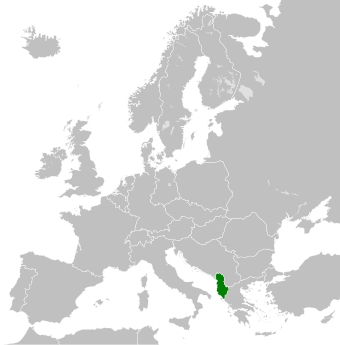People's Socialist Republic of Albania
|
Republika Popullore Socialiste e Shqipërise Socialist People's Republic of Albania 1944–1990 |
|||||
|
|||||
|
|||||
|
Motto : Proletarë të të gjitha vendeve, bashkohuni ( Albanian for " Workers of the world united you! ") |
|||||
| Official language | Albanian | ||||
| Capital | Tirana | ||||
| Form of government | People's Republic | ||||
| Form of government | Socialist one-party system | ||||
| Head of state | Party secretary | ||||
| Head of government | Prime Minister | ||||
| surface | 28,748 km² (1989) | ||||
| Residents | 3,182,417 (1989) | ||||
| Population density | 110.7 inhabitants per km² (1989) | ||||
| currency |
Albanian Lek (1 Lek = 100 Qindarka) |
||||
| founding | May 24, 1944 November 29, 1944 Liberation Day |
||||
| resolution | December 11, 1990 fall of communism |
||||
| National anthem |
Himni i Flamurit |
||||
| National holiday | November 28th Flag Day |
||||
| Time zone |
UTC +1 CET UTC +2 CEST (March to October) |
||||
| License Plate | AL | ||||
| ISO 3166 | AL , ALB, 008 | ||||
| Telephone code | +355 | ||||
| map | |||||

|
|||||
The Socialist People's Republic of Albania ( Albanian Republika Popullore Socialiste e Shqipërisë , RPSSh for short ) was a state in south-eastern Europe that existed in this form from 1944 to 1990. After its founding on May 24, 1944 and after the withdrawal of the Wehrmacht on November 29, 1944, it was established nationwide, until 1990 a real socialist one-party dictatorship under the leadership of the Party of Labor of Albania (PAA), which devoted itself to Marxism-Leninism , Stalinism and Maoism known. The Socialist People's Republic of Albania saw itself as the dictatorship of the proletariat , which represented and defended the interests of the working class . After the fall of the Iron Curtain , the PAA was renamed the Socialist Party of Albania (Partia Socialiste e Shqipërisë) and, as one of the two largest parties, has repeatedly appointed the Prime Minister .
The People's Socialist Republic of Albania was a founding member of the Warsaw Pact and belonged from 1949 to the CMEA -Staaten Eastern Europe , making them part of the so-called Eastern Bloc was. This collaboration ended in 1961, and in 1968 the Warsaw Pact was abandoned. The ban on religion established in 1967 made Albania the first and so far only official atheist state in the world.
All over the country, thousands of bunkers and hundreds of monuments, so-called lapidars , remind of the communist era.
The capital of the Albanian People's Republic was Tirana .
history
The National Liberation Movement (LNÇ) liberated Albania from the Wehrmacht on November 29, 1944 , practically ending the Second World War in their own country. The anti-fascist National Liberation Council , founded in May, formed the provisional state government for the next two years. Like the LNÇ, they were dominated by the Communist Party of Albania (later renamed the Labor Party of Albania ) and its first party secretary, Enver Hoxha , who was appointed Prime Minister of Albania.
From the beginning, the LNÇ regime was an undisguised Stalinist dictatorship . After they had eliminated the nationalist partisan movement Balli Kombëtar and sentenced, executed or forced to flee all other opposition members with or without a show trial to prison terms of several years to life, the LNÇ increasingly consolidated its power. All connections to the non-real socialist world were broken off.
Koçi Xoxe , who later became Vice President and Minister of the Interior, oversaw the planning and execution of the countless executions of thousands of opposition politicians, clan leaders and members of previous Albanian governments under the pretext that they were all “war criminals”. Thousands of her family members were also sent to prison or forced labor camps for years.
The consolidation of communist control also resulted in a territorial shift in political power in Albania. While before it was mainly the northern Albanians who opposed the governments, after the war it was mostly southern Albanian Tosks . The majority of the communist leaders were middle-class Tosks and the party recruited most of its supporters from the Tosken-inhabited regions of Albania.
On December 2, 1945, the Albanians elected a people's constituent assembly . However, only candidates from the Democratic Front (the former National Liberation Movement) were eligible for election . Using propaganda and terrorist tactics, the communists finally won with allegedly 93 percent of the votes cast. The turnout was 92 percent.
List of political leaders

General Secretaries of the Party of Labor of Albania :
- Enver Hoxha (1944–1985)
- Ramiz Alia (1985-1991)
Chair of the Presidium of the National Assembly:
- Omer Nishani (1946-1953)
- Haxhi Lleshi (1953-1982)
- Ramiz Alia (1982-1991)
Prime Minister:
- Enver Hoxha (1945–1954)
- Mehmet Shehu (1954-1981)
- Adil Çarçani (1982–1991)
See also
Web links
Individual evidence
- ^ Constitution of the People's Socialist Republic of Albania from 1976. Stanford University Libraries, accessed November 9, 2012 (Albanian).
- ↑ Michael Schmidt-Neke: Can Albania explain North Korea? In: Albanian notebooks. 4/2004, p. 14.
- ^ Spiegel: Bunkerland Albania: Everyone under cover . August 6, 2012. Retrieved May 16, 2017.

